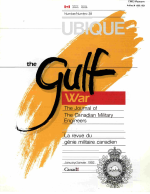Both Iraq and Kuwait achieved independence in the 20th century. The relationship between the two countries, however, had not been smooth. Iraq had long felt that Kuwait was really a part of Iraq and that Kuwaiti oil rigs were illegally tapping into Iraqi oil fields. In the late 1980s, tensions grew and relations became much worse. On 2 August 1990, the situation came to a head when Iraqi forces invaded Kuwait and quickly took control of its much smaller neighbour.
The United States lead a coalition to force Iraq out of Kuwait. Canada's first military contributions came at sea in August 1990, when three warships sailed to the Persian Gulf to be part of a Coalition fleet that would secure the waters off Iraq and occupied Kuwait. Canadian CF-18 warplanes were sent to the Middle East in October to help take control of the skies above the Gulf.
On 16 January 1991, after Iraq ignored a final deadline for withdrawal, Operation DESERT STORM began when Coalition forces launched a devastating air campaign. This was followed by an armoured and infantry ground offensive on 24 February that rapidly pushed the Iraqis out of Kuwait. Having fulfilled their mandate to liberate Kuwait, the Coalition forces ceased the offensive on 28 February and offered a cease-fire that Iraq accepted on 3 March. After the Gulf War ended, Canadian troops remained in the region as part of the UN peacekeeping mission along the Iraq-Kuwait border, monitoring the demilitarized zone between the two countries, investigating cease-fire violations and clearing land mines and other unexploded ordnance.
More than 4,000 Canadian Forces personnel served in the Persian Gulf region during the Gulf War. The Canadian Military Engineers proved to be invaluable assets in the support of both air operations and land operations. From the initial planning and recce of a desert home for the Canadian Air Contingent for the Gulf War in Kuwait through to the direct support of allied engineers in the clean-up of unexploded ordnance after the war, the Canadian Military Engineers displayed their flexibility, versatility and professionalism.
The CME contribution to the Persian Gulf War was a key turning point in its role of supporting the RCAF. In short order, the theatre accommodation and working facilities Canadian Air Task Group Middle East were constructed. In addition to the facilities, works and utilities necessary for living and operating in the desert, Canadian Military Engineers also constructed the necessary extension to the runway ramp, installed and operated the arresting gear, provided crash and fire rescue for the airfield and provided fire protection for the camp. Operation SCIMITAR/FRICTION reinforced the realization that the Air Force needed the Engineers to deploy from its static bases.
Canada’s Army Engineers made their most significant contribution to the Persian Gulf War during the immediate aftermath of the war. The initial work was launched only days after the ceasefire with Operation MAGNOLIA using in-theatre engineer resources for explosive ordnance work. 1 Combat Engineer Regiment was soon deployed in late April on Op RECORD in what was Canada’s largest Army Engineer overseas deployment since the Korean War. Their work assisted in the early recovery of Kuwait City and included extensive EOD operations to restore mobility.
The regiment supported the establishment of a demilitarized zone along the Iraq-Kuwait border in order to enable the deployment of the United Nations Iraq-Kuwait Observation Mission (UNIKOM) peacekeepers. Through the multiple hazards of unexploded ordnance, extreme desert heat, and oil fire smoke, they built a network of observation posts and patrol routes along the 220-kilometer border. Canadian engineers cleared more than 1,000 kilometres of new track and kept 2,000 kilometres of existing roads and track passable and safe. Success of this CME mission ensured that the massive effort of the coalition forces during the war was complemented by a rapid and orderly transition to peace along the Iraq-Kuwait border.
To remind us of the work and accomplishments of our CME personnel who deployed to Kuwait during the Gulf War and contributed greatly to the coalition’s success, we have attached a reproduction of the January 1992 Special Gulf War Edition No 38 of the UBIQUE periodical.
